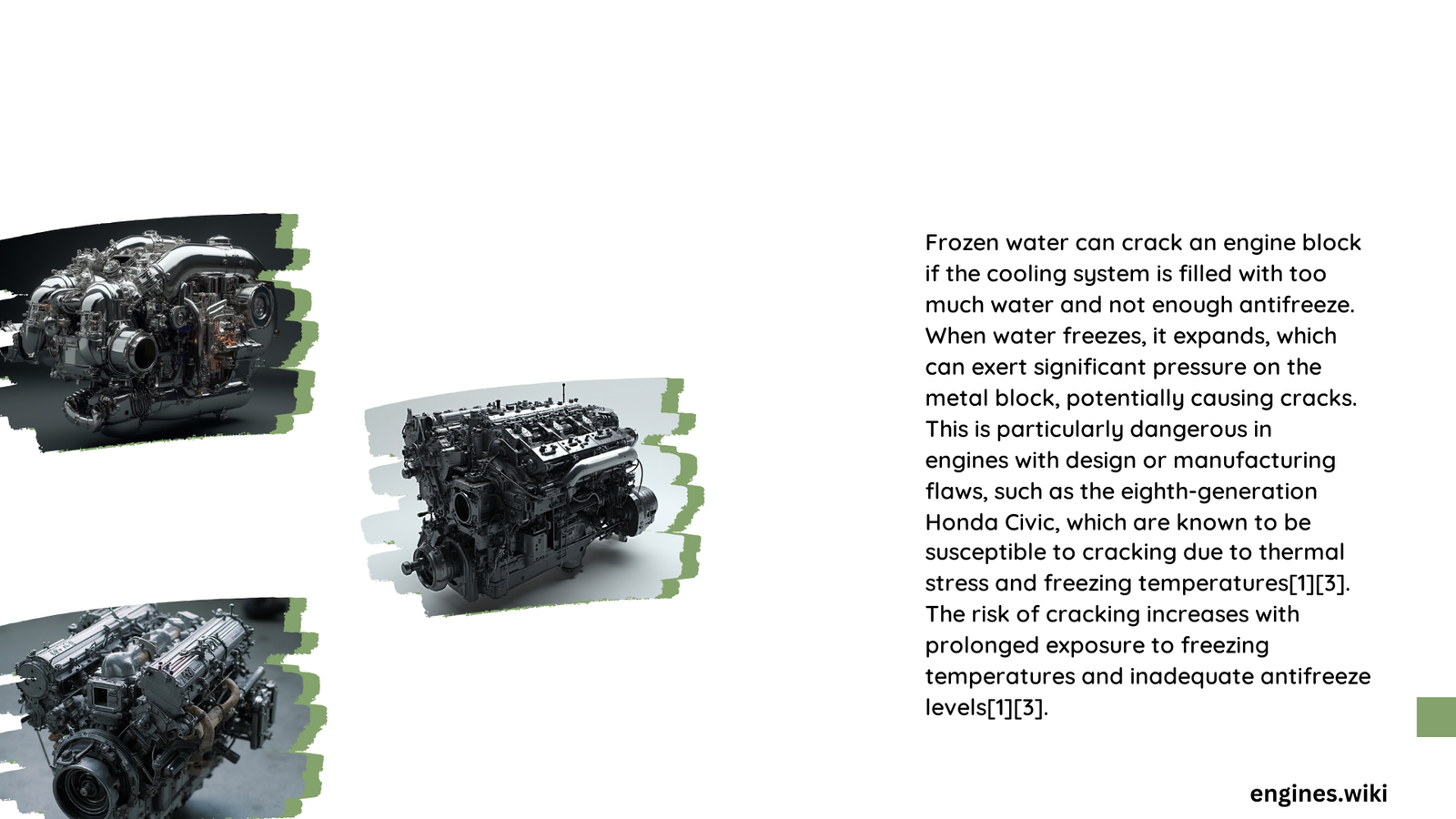Frozen water can indeed crack an engine block, posing a serious threat to vehicle engines in cold climates. This phenomenon occurs when water inside the engine freezes and expands, exerting immense pressure on the metal walls. The expansion can lead to cracks or complete failure of the engine block, resulting in costly repairs or replacements. Understanding the mechanics behind this issue, its prevention, and the potential consequences is crucial for vehicle owners, especially those living in areas prone to freezing temperatures.
What Temperature Causes Water to Freeze in an Engine Block?
Water in an engine block typically freezes at or below 32°F (0°C). However, the risk of damage increases significantly when temperatures drop further:
- 20-30°F (-7 to -1°C) for 6-8 hours can be sufficient to cause damage
- Lower temperatures accelerate the freezing process
- Prolonged exposure increases the risk of ice formation and expansion
It’s important to note that pure water freezes at 32°F, but engine coolant mixtures have lower freezing points, which is why they’re essential in cold climates.
How Does Ice Expansion Affect the Engine Block?

When water freezes, it expands by approximately 9%. This expansion in a confined space like an engine block can have devastating effects:
- Pressure buildup: As ice forms, it exerts pressure on the surrounding metal
- Material stress: The pressure can exceed the structural limits of the engine block material
- Crack formation: Weak points in the block may develop cracks under the strain
- Complete failure: In severe cases, the block can split or shatter
The expansion force of freezing water is so powerful that it can crack even thick metal walls of an engine block.
What Are the Signs of a Cracked Engine Block Due to Freezing?
Identifying a cracked engine block early can prevent further damage. Look out for these symptoms:
- Coolant leaks: Visible puddles under the vehicle or low coolant levels
- White exhaust smoke: Indicates coolant burning in the combustion chamber
- Engine overheating: Due to loss of coolant
- Oil contamination: Milky appearance in oil due to coolant mixing
- Rough running: Engine misfires or poor performance
- Visible cracks: In severe cases, cracks may be visible on the engine block
If you notice any of these signs, especially after a cold snap, have your vehicle inspected immediately.
How Can You Prevent Water from Freezing in Your Engine Block?
Preventing frozen water damage is far easier and less costly than repairing a cracked engine block. Here are some effective preventive measures:
- Use proper coolant mixture:
- Maintain a 50/50 mix of antifreeze and water
- Check coolant concentration with a hydrometer
-
Use coolant rated for your climate’s lowest temperatures
-
Winterize your vehicle:
- Flush and refill coolant before winter
- Inspect hoses and belts for wear
-
Consider using a block heater in extremely cold areas
-
Regular maintenance:
- Follow manufacturer’s recommendations for coolant changes
- Check coolant levels regularly
-
Address any leaks promptly
-
Protect your vehicle:
- Park in a garage or sheltered area when possible
- Use an engine block heater for outdoor parking in freezing temperatures
- Allow the engine to warm up before driving in cold weather
What Are the Repair Costs for a Cracked Engine Block?
The cost to repair or replace a cracked engine block can be substantial:
| Repair Type | Estimated Cost Range |
|---|---|
| Minor Crack Repair | $1,500 – $3,000 |
| Major Crack Repair | $3,000 – $5,000 |
| Engine Block Replacement | $5,000 – $10,000+ |
Factors affecting the cost include:
– Vehicle make and model
– Engine type and size
– Extent of damage
– Labor costs in your area
Given these high costs, prevention is clearly the best strategy for dealing with potential freezing damage.
How Common Are Cracked Engine Blocks from Freezing?
While exact statistics are hard to come by, cracked engine blocks due to freezing are:
- More common in regions with severe winters
- Often associated with poor maintenance or neglect
- Relatively rare in well-maintained vehicles
- More frequent in older vehicles or those with pre-existing cooling system issues
Anecdotal evidence suggests that boats and recreational vehicles stored outdoors in winter are at higher risk due to improper winterization.
What Role Does Thermal Shock Play in Engine Block Cracking?
Thermal shock can contribute to engine block cracking, especially in cold climates:
- Rapid temperature changes stress the metal
- Different parts of the engine cool at different rates
- Repeated thermal cycling can weaken the metal over time
- Aluminum blocks are more susceptible due to higher thermal expansion rates
To minimize thermal shock:
– Allow the engine to warm up gradually in cold weather
– Avoid pouring hot water on a frozen engine block
– Use a block heater to maintain a more consistent temperature
By understanding the risks and taking appropriate precautions, vehicle owners can significantly reduce the chance of experiencing a cracked engine block due to frozen water. Regular maintenance, proper coolant use, and winterization practices are key to protecting your engine in cold climates.
References:
1. Car From Japan – Crack On Engine Block: How It Happens?
2. OffshoreOnly – What does it take to freeze & crack an engine block?
3. Toyota Creek Motors – What are the Signs of a Cracked Engine Block
